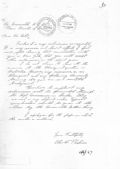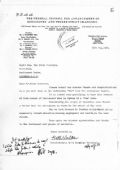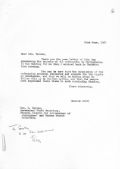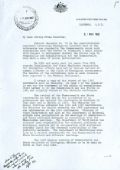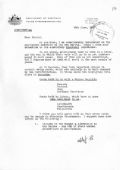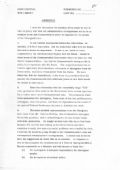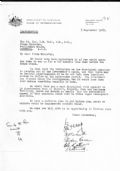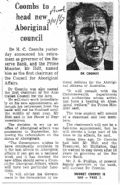Aftermath
Indigenous responses
Charles Perkins, Vice-President of the Federal Council for the Advancement of Aborigines and Torres Strait Islanders (FCAATSI), referred to the referendum as 'the moment of truth whether the white people really are interested in our welfare or rights'. [1]
He wrote to the Prime Minister Harold Holt setting out his ideas about how the government might use its new power.
Letter from Charles Perkins to Harold Holt, June 1967
A1209, 1967/1512, National Archives of Australia, Canberra
More info on Letter from Charles Perkins to Harolt Holt, June 1967
Perkins had met Harold Holt in New York in June and the Prime Minister had invited him to submit his ideas on how the government might respond to the mandate in Aboriginal affairs. Perkins suggested the development of a Federal Aboriginal Affairs Bureau, which might see employment and education as priorities. He also referred briefly to the issue of land ownership and recognition of Aboriginal status as original owners.
The strong YES vote signified community acceptance for him, as it did for Doug Nicholls, Joe McGinness, Kath Walker, Bert Groves, Bill Onus and Chicka Dixon.
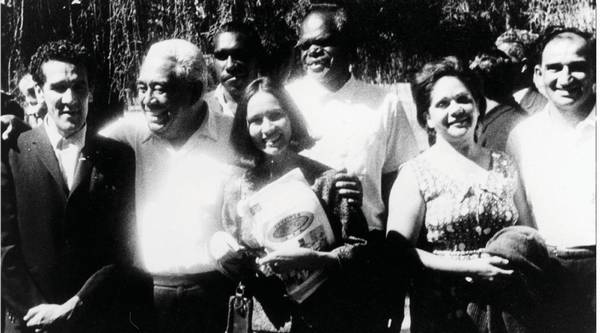
Charles Perkins, Bill Onus on the left, Lupna Giari is third from right, Merle and Alick Jackomos are on the right.
Source: Courtesy Marjorie Broadbent
Kath Walker, who had directed the Queensland campaign, wrote to congratulate the Prime Minister and looked forward to 'further enlightened policy' in the near future. The Prime Minister, in response, referred to 'further action, now that the people have expressed their views in such a convincing fashion'.
Letter from Kath Walker to Harold Holt, May 1967
A1209, 1967/1512, National Archives of Australia, Canberra
More info on Letter from Kath Walker to Harold Holt, May 1967
Letter from Harold Holt to Kath Walker, June 1967
A1209, 1967/1512, National Archives of Australia, Canberra
More info on Letter from Harold Holt to Kath Walker, June 1967
Some Aboriginal and Islander activists, people with a lifetime of experience of disadvantage were moved by the size of the vote. Harriet Ellis, Aboriginal convenor of the NSW Trades Hall 'Vote Yes' Subcommittee, considered that the referendum result 'would help to eliminate an inferiority complex'. She believed that Aboriginal people 'particularly want to be counted as Australians'. [2] Speaking thirty years after the event, Harry Penrith (later known as Burnum Burnum), a Federal Council committee convenor, concurred: 'personally, it made me lose my inferiority complex'. [3] Some Aboriginal people have suggested that, prior to 1967, they felt that there was no point in voting because political parties showed no interest in their concerns. After the referendum, however, they felt less ignored and more inclined to use their vote. The 1967 Referendum, or When Aborigines Didn't Get the Vote, Canberra, 1997, pp. 138-139. Such comments also help to explain why 1967 has often been remembered as the time when the right to vote was granted even though the Commonwealth Electoral Act extending the vote federally to all Aboriginal and Islander people was passed in 1962. See Heather Goodall, 'Aboriginal history and the politics of information control', in R White and P Russell (eds), Memories and Dreams: Reflections on Twentieth Century Australia, Sydney, 1997, for an insightful discussion of how oral evidence might be read.[4]
Other Aboriginal and Islander people saw the passage of the referendum as irrelevant to their lives or as having a negative effect. Elizabeth Hoffman, interviewed in 1997, commented that the referendum 'didn't really affect everyday life - you still now have to fight for things. We had to fight for anything we ever got and are still doing it'. David Mowaljarlai argued that the referendum 'made things worse for my people. Drinking and those sorts of freedoms have caused things to be much worse'. Bev Elphick saw the referendum as only having created more politicians. The 1967 Referendum: Race, Power and the Australian Constitution, Aboriginal Studies Press, 2007. [5]
Parliamentary responses
Charles Barnes, Minister for Territories, favoured maintaining the status quo, in which the Commonwealth gave some policy direction such as establishing that assimilation was the agreed policy basis for all states and territories with regard to Aboriginal affairs. He added, however, that there seemed to be a need to define the Commonwealth's role in Aboriginal affairs.
Letter from Charles Barnes to Acting Prime Minister, May 1967
A1209, 1967/1512, National Archives of Australia, Canberra
More info on Letter from Charles Barnes to Acting Prime Minister, May 1967
William Wentworth, the government member who had been most interested in Aboriginal issues, drew the Prime Minister's attention to the electoral angle. If Aboriginal voters voted in a block for Labor seven northern Australian seats could be in doubt.
Letter from William Wentworth to Harold Holt, June 1967
A1209, 1967/1512, National Archives of Australia, Canberra
More info on Letter from William Wentworth to Harold Holt, June 1967
The Prime Minister's Cabinet submission of July or August 1967 stressed joint arrangements with the states, and warned against magnifying 'the Aborigine problem out of its true reality'. But it also referred to the establishment of a Bureau of Aboriginal Affairs.
By early September five Members of Parliament (MPs) with seats in northern Australia were getting nervous. They wrote of 'serious repercussions' if the government failed to come up with a plan of action in Aboriginal affairs.
Letter from Queensland Members of Parliament to the Prime Minister, September 1967
A1209, 1967/1512, National Archives of Australia, Canberra
More info on Letter from Queensland Members of Parliament to the Prime Minister, September 1967
Finally, more than five months after the electorate voted so strongly for federal power in Aboriginal affairs, the Prime Minister announced the setting up of a Council for Aboriginal Affairs, to be headed by the governor of the Reserve Bank, the widely respected HC Coombs. This Council, a statutory body, would play a key role in the next few years, listening to Indigenous Australians and providing policy advice to the federal government.
With the election of a Labor government at the end of 1972 Gordon Bryant became the first Minister for Aboriginal Affairs supported by a department. For the activists in FCAATSI and outside it the idea of a Commonwealth government passing legislation in Indigenous affairs and then, under section 109 of the Constitution, challenging Queensland, seemed possible.
Related resources
People
Gordon Bryant
HC Coombs
Chicka Dixon
Harriet Ellis
Bert Groves
Joe McGinness
Doug Nicholls
Bill Onus
Harry Penrith
Charles Perkins
Kath Walker
William Wentworth
Organisations
Council for Aboriginal Affairs
Federal Council for the Advancement of Aborigines and Torres Strait Islanders
Footnotes
1 Cited by Bill Onus, Director, Vote Yes Campaign Committee, 'Aboriginal Rights and the Referendum', nd, Bryant papers, MS 8256/175, National Library of Australia.
2 H Ellis, Sydney Morning Herald, 27 May 1967.
3 Bain Attwood and Andrew Markus, The 1967 Referendum: Race, Power and the Australian Constitution, Aboriginal Studies Press, 2007.
4 Conversations with Len Fox, Josie Briggs and others. See also comments by Leisha May Eatts and Tjuka Pumpjack, 'Aboriginal oral sources', in Bain Attwood and Andrew Markus, The 1967 Referendum, or When Aborigines Didn't Get the Vote, Canberra, 1997, pp. 138-139. Such comments also help to explain why 1967 has often been remembered as the time when the right to vote was granted even though the Commonwealth Electoral Act extending the vote federally to all Aboriginal and Islander people was passed in 1962. See Heather Goodall, 'Aboriginal history and the politics of information control', in R White and P Russell (eds), Memories and Dreams: Reflections on Twentieth Century Australia, Sydney, 1997, for an insightful discussion of how oral evidence might be read.
5 'Aboriginal Oral Sources' (compiled by Dale Edwards and Kath Schilling) in B Attwood and A Markus, The 1967 Referendum: Race, Power and the Australian Constitution, Aboriginal Studies Press, 2007.
